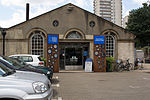Brompton Bicycle

Brompton Bicycle is a British manufacturer of folding bicycles based in Greenford, London.The Brompton folding bicycle and accessories are the company's core product, noted for its self-supporting compact size when stored. All available models of the folding bicycle are based on the same hinged frame and 16-inch (35×349 mm) tyre size. Components are added, removed, or replaced by titanium parts to form the many variations. The modular design has remained fundamentally unchanged since the original patent was filed by Andrew Ritchie in 1979, with small details being refined by continual improvement. Ritchie was awarded the 2009 Prince Philip Designers Prize for work on the bicycle.Brompton is the largest volume bicycle manufacturer in Britain, producing approximately 50,000 bicycles each year. The company's bicycles are also available for hire.
Excerpt from the Wikipedia article Brompton Bicycle (License: CC BY-SA 3.0, Authors, Images).Brompton Bicycle
Lionel Road South, London
Geographical coordinates (GPS) Address Website Nearby Places Show on map
Geographical coordinates (GPS)
| Latitude | Longitude |
|---|---|
| N 51.4907 ° | E -0.2931 ° |
Address
Mercedes-Benz
Lionel Road South
TW8 9QR London (London Borough of Hounslow)
England, United Kingdom
Open on Google Maps









